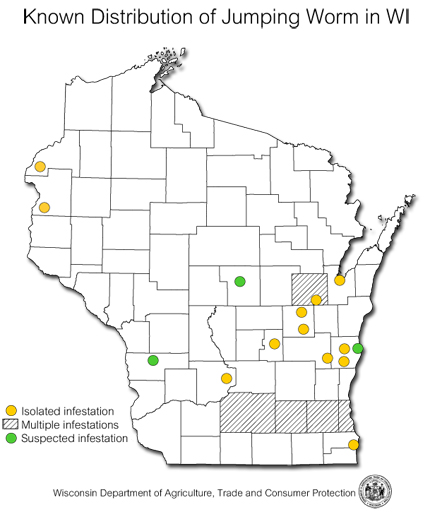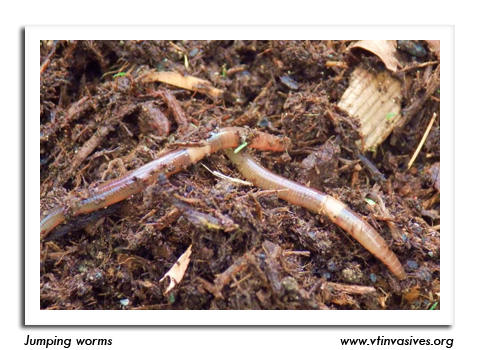
 |
|
|
Nursery & Forest
Volume 60 Number 2 Date 04/30/2015 JUMPING WORM - This invasive East Asian worm has to date been found in 14 Wisconsin counties (Brown, Burnett, Dane, Green Lake, Fond du Lac, Jefferson, Milwaukee, Outagamie, Polk, Racine, Sauk, Sheboygan, Waukesha and Winnebago) and is suspected in another two (Portage and Vernon). First reported in the state in 2013, the jumping worm is thought to have arrived with plants imported for landscaping. This species (Amynthas agrestis) reproduces easily, matures in only 60 days, and rapidly degrades infested soils into dry, grainy worm castings that cannot support native organisms. The jumping worm is also sold as live bait and for composting under the common names, crazy worms, Alabama jumpers and snake worms. DNR forest health specialists believe the jumping worm is not yet widely distributed in Wisconsin, thus vigilance can help slow its spread. New precautionary guidelines have been developed for nurseries, garden centers and landscape contractors and may be obtained by emailing datcp.nursery@wisconsin.gov. APHIDS - Infestations were observed on amethyst flower, firecracker flower, geranium 'Red Blizzard' and mandevilla vine at a Racine County retailer. Aphids are difficult to control in greenhouses due to their high reproductive capacity and resistance to insecticides. Early detection and control requires weekly scouting of plants prior to flowering. Should treatment be justified, two applications of an insecticide registered for aphid control are typically needed. Insecticidal soaps and horticultural oils kill by contact, so thorough coverage of the undersides of leaves is critical. -- Ellen Hermanson, DATCP Nursery Inspector VIRUS SURVEY OF ORNAMENTALS - Nursery inspectors are again sampling production greenhouses in 2015 for virus-infected ornamentals. A primary objective of the survey is to intercept new deleterious viruses before they become more widely disseminated in the state. This year's virus testing includes screening for up to 12 viruses and is being conducted by the DATCP Plant Industry Laboratory, with funding from the USDA. Wholesale greenhouse growers interested in participating in the virus survey should contact their DATCP regional nursery inspector before May 15: http://datcp.wi.gov/uploads/Plants/pdf/NurseryInspectorMap.pdf . The survey will conclude after June 30. -- Anette Phibbs, DATCP Plant Pathologist GYPSY MOTH - Egg hatch was reported for the first time this season on April 24 in Rock County and April 28 in Chippewa County. Aerial spray treatments are likely to start in southern Wisconsin late in the week beginning May 3 or early in the week beginning May 10. Treatments are scheduled in the following counties: Barron, Bayfield, Buffalo, Burnett, Chippewa, Crawford, Dane, Douglas, Dunn, Eau Claire, Green, La Crosse, Lafayette, Monroe, Polk, Richland, Rock, Rusk, Sawyer, Trempealeau, Vernon and Washburn. Airplanes will apply Bacillus thuringiensis var. kurstaki, an OMRI-listed biological insecticide acceptable for use in certified organic operations. Select areas in Eau Claire County will be treated with Gypchek, a viral insecticide specific to gypsy moth. Spraying may start at sunrise and last throughout the day as weather permits. At most sites, a second application will be done three to seven days after the first application. -- Rick Hummell, DATCP Gypsy Moth Program 




|
|
|